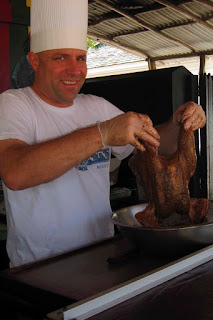Alright mon, thought that I would try something a little different. Maybe a little Jerk Chicken! What better place to learn than Mantego Bay, Jamaica. My wife and I were here for a little R&R when we saw 'The Art of Making Jerk' cooking class in the hotel activity brochure. After giving the jerk a try for lunch, this turned into a must do for the vacation.
The Jerk Centre is located just 25 feet off of the Jamaican shoreline at the beautiful Ritz-Carlton Hotel.


Jerk shacks thrive on the sides of the road in Jamaica as a local fast-food industry. The term
jerk is said to come from the word
charqui, a Spanish term for jerked or dried meat. It eventually became
jerky in English. Another origin is linked to the jerking or poking of the meat with a sharp object, producing holes which were then filled with a spice mixture. Jerk was an ingenious way to preserve meat out in the wilderness.

Jerk seasoning has two key ingredients: scotch bonnet pepper and allspice berry.
The scotch bonnet pepper is a variety of the habanero and got its name for its shape resembling a Scotch tam or hat. The colors range from green to yellow to red. The chiles not only add a spicy flavor, but also preserve foods when refrigeration was not easy to come by. You can substitute jalapenos, but it is worth the effort to hunt down the real thing. Reduce the heat by removing the seeds and veins from the pepper.
The allspice berry is a popular spice in Jamaica. This is not the same as the ground combination spice powder often used in pumpkin pies, but is the berry of the evergreen pimento tree which is native to the West Indies and South America. The dark brown, dried berries have an aroma similar to the combination of cinnamon, nutmeg, and cloves.
Other spices and herbs may include thyme, cinnamon, ginger, cloves, garlic, and scallion (depending on the cook).

Our instructor, Keisha, was going to show us how to combine these ingredients into the jerk.

In Jamaica, there are 2 types of jerk marinades, wet and dry. The dry rub is used when you are in a hurry and need to make a quick dinner. We focused on the wet rub that is more flavorful, infusing the meat all the way to the bone. It can be used on chicken, pork, seafood, or tofu.
Jerk Marinade (Wet)- 1/4 cup allspice berries
- 10 scotch bonnets, stems and seeds removed
- 1/2 cup scallions, chopped
- 1/2 cup onion, chopped
- 4 garlic cloves, chopped
- 4 bay leaves, crushed
- 1/3 cup ginger, peeled and chopped
- 1/3 cup fresh thyme
- salt to taste
- 1 tablespoon ground black pepper
- 3/4 cup vegetable oil
- 1/2 cup soy sauce
Blend all of the ingredients thoroughly.

After the marinade was made, I had the honor of marinating the meat. We used a whole chicken with the back removed. A cup of the marinade was rubbed thoroughly into the meat. I also was instructed to gently separate the pocket of skin along each breast and to rub the marinade into the space.


Chicken or pork should be marinated between 1 and 2 days for the flavors to work themselves all the way to the bone. Seafood can be marinated right before cooking.
Jerked items are traditionally cooked slowly over pimento wood. I think that in the absence of a pimento wood fire, the key to authenticity is a slow, smokey fire. Keisha also mentioned that barbecue or baking the meat also comes out pretty good, no problem mon.
The final step to the jerk is to make the jerk sauce. This sauce not only goes perfectly with the jerk meat, but the spicy, sweet sauce works great on just about anything.
Mild Jerk Sauce- 2 cups Jerk Marinade (Wet)
- 1/4 cup Leam Perry Sauce
- 4 ounce Tabasco Sauce
- 3 cups pineapple juice
- 1 cup Ketchup
- 3 cups sweet chili sauce
- 1 cup soy sauce
- 1/2 cup honey
- 10 scotch bonnets (whole with stems on)
Blend all the ingredients thoroughly. This stuff keeps for a couple of weeks on the counter or indefinitely in the refrigerator. To spice it up, put in 15 scotch bonnets and 8 ounces of Tabasco sauce. Your lips are going to be hot!

This chicken was amazing and the sauce was phenomenal. Looking forward to trying this at home.


 Now that the barbecue had been initiated, it was time for something a little more complicated, slow roasting a whole chicken prepared with jerk marinade. I am so glad that I had researched the Outdoor Chef City Grill 420 ahead of time. It really lives up to its reputation and high reviews. I was amazed how I was able to control the temperature within about five degrees for long periods of time.
Now that the barbecue had been initiated, it was time for something a little more complicated, slow roasting a whole chicken prepared with jerk marinade. I am so glad that I had researched the Outdoor Chef City Grill 420 ahead of time. It really lives up to its reputation and high reviews. I was amazed how I was able to control the temperature within about five degrees for long periods of time.

 This chicken cooked for an hour over 275 degree heat. It really was falling off the bone. The marinated was infused in the juicy meat and the jerk sauce was spicy, sweet, and wonderful.
This chicken cooked for an hour over 275 degree heat. It really was falling off the bone. The marinated was infused in the juicy meat and the jerk sauce was spicy, sweet, and wonderful.








